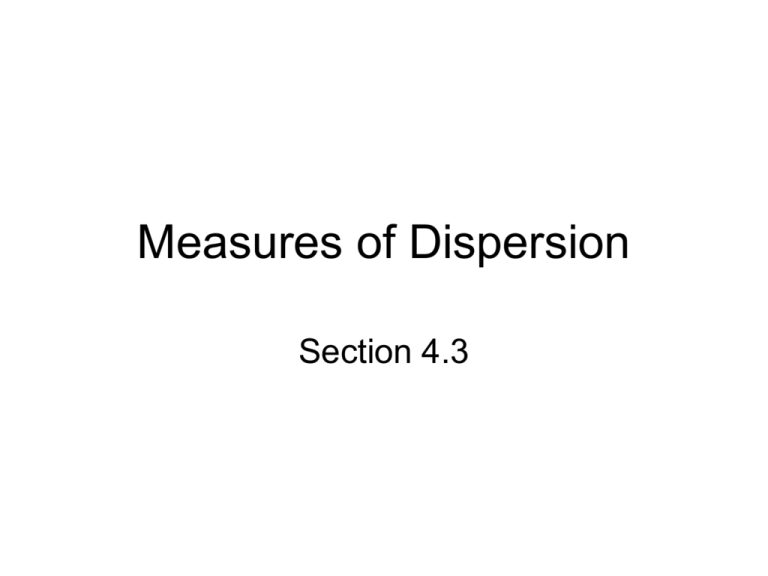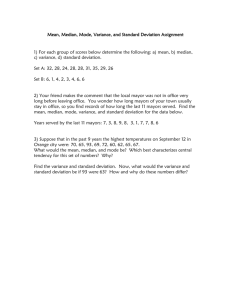Measures of Dispersion
advertisement

Measures of Dispersion Section 4.3 The case of Fred and Barney at the bowling alley • Fred and Barney are at the bowling alley and they want to know who’s the better bowler. • They bowl six games and here are the results: Fred 185 135 200 185 155 250 Barney 182 185 188 185 180 190 Find the average, Find the median, Find the mode!!! • After the games it’s time for Fred and Barney to do the math. • We compute Fred’s mean and we see it is 185. • Barney’s mean is computed and it is also 185. • We look at Fred’s median it’s 185. • Barney’s median is also 185. • The mode for Fred is 185 and the mode for Barney is 185. • Make sure you can do these calculations. Mr. Consistency vs. Mr. Loose Cannon • If we look at the scores we notice that Barney’s scores are very consistent. They do not vary much around his average. • Fred however has wildly varying scores. His last game was 250, so maybe he’s Mr. Clutch. • Statistically speaking we would like to measure this variation about the mean. • What we need to do is to calculate deviations from the mean, sample variance, and sample standard deviation. Deviation from the mean • First let’s calculate the deviation from the mean for each score. • The formula is d i x x . • For Fred the avg. of his scores is 185. • d1 = 185 – 185 = 0 • d2 = 135 – 185 = -50 • d3 = 200 – 185 = 15 • d4 = 185 – 185 = 0 • d5 = 155 – 185 = -30 • d6 = 250 – 185 = 65 • The sum of the deviations is zero! This is always true. • What we need to do is get rid of those pesky minus signs. The sample variance • The measurement we need is called the sample variance. • What we do is we square each deviation and then sum them up and divide by one less the number of data points. • The formula is give as: 1 1 2 2 s ( x x ) d i i n 1 i n 1 i 2 The Sample variance for Fred • Lets calculate the sample variance for Fred. 1 s (0 2 (50) 2 (15) 2 (0) 2 (30) 2 (65) 2 ) 6 1 1 2 s (0 2500 225 0 900 4225) 5 7850 2 s 1570 5 2 The standard deviation. • Since we want an understanding of how the data is dispersed about the mean, then the statistic that measures this must be of the same units as the mean. • Unfortunately the sample variance is the square of these units. So what we should do is take the square root of the sample variance. • This is called the sample standard deviation. • Sample Standard Deviation = sample variance The standard deviation for Fred • We can now calculate Fred’s sample standard deviation. s 1570 39.62 • You should calculate Barney’s sample variance and sample standard deviation. 2 • They are s 13.6 s 13.6 3.69 One Standard deviation from the mean • Sometimes it is useful to compute the percentage of the data that is one standard deviation from the mean. • What you need to do is first compute the mean of the sample. • Then compute the standard deviation of the sample. • Next, you want to construct the interval that is one standard deviation from the mean. • The left end point is x s. • The right end point is x s. • Find the number of data points that fall into this range and then divide by the total number of data points. • When this number is close to 68%, this is indicative of a normal distribution.







